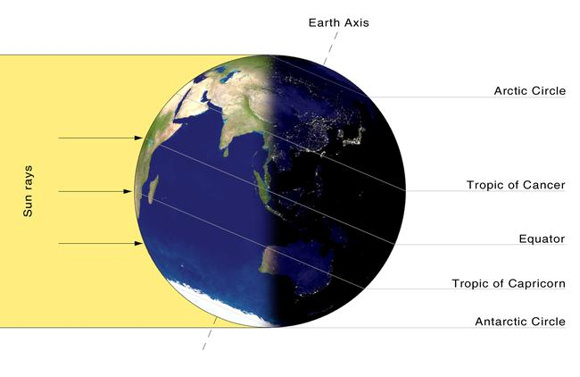

Spring sunrise over the South Pole. Image via NASA Earth Observatory.
Question: Where on Earth does noon only come once a year?
Answer: At the South Pole, and it happens on the December solstice.
That’s if we define “day” by successive noons (successive sunsets, successive midnights or successive sunrises). Using that definition, a day lasts a year at the North and South Poles. Sunrise comes every year around the spring equinox, noon at the summer solstice, sunset around the autumnal equinox and midnight at the winter solstice.
Meanwhile, on the December winter solstice, it’s midnight at the other end of the world, at the Earth’s North Pole. According to the definition of “day” above, midnight comes only comes once a year for the North and South Poles.
Some three months after the December solstice, around the March equinox, the sun will finally set at the South Pole and rise at the North Pole. Some six months after the December solstice, at the June solstice, it’ll be noon at the North Pole and midnight at the South Pole. Nine months after the December solstice, around the September equinox, it’ll be sunrise at the South Pole and sunset at the North Pole.

At the December solstice, the sun is shining at zenith (straight overhead) at the tropic of Capricorn, at which moment it is noon at the South Pole and midnight at the North Pole.
Bottom line: At the North and South Poles, sunrise comes at the spring equinox, noon at the summer solstice, sunset on the autumn equinox and midnight at the winter solstice.
EarthSky lunar calendars are cool! They make great gifts. Order now. Going fast!
Want to see 2018’s brightest comet? How to see comet 46P/Wirtanen
from EarthSky http://bit.ly/2rMDnU2


Spring sunrise over the South Pole. Image via NASA Earth Observatory.
Question: Where on Earth does noon only come once a year?
Answer: At the South Pole, and it happens on the December solstice.
That’s if we define “day” by successive noons (successive sunsets, successive midnights or successive sunrises). Using that definition, a day lasts a year at the North and South Poles. Sunrise comes every year around the spring equinox, noon at the summer solstice, sunset around the autumnal equinox and midnight at the winter solstice.
Meanwhile, on the December winter solstice, it’s midnight at the other end of the world, at the Earth’s North Pole. According to the definition of “day” above, midnight comes only comes once a year for the North and South Poles.
Some three months after the December solstice, around the March equinox, the sun will finally set at the South Pole and rise at the North Pole. Some six months after the December solstice, at the June solstice, it’ll be noon at the North Pole and midnight at the South Pole. Nine months after the December solstice, around the September equinox, it’ll be sunrise at the South Pole and sunset at the North Pole.

At the December solstice, the sun is shining at zenith (straight overhead) at the tropic of Capricorn, at which moment it is noon at the South Pole and midnight at the North Pole.
Bottom line: At the North and South Poles, sunrise comes at the spring equinox, noon at the summer solstice, sunset on the autumn equinox and midnight at the winter solstice.
EarthSky lunar calendars are cool! They make great gifts. Order now. Going fast!
Want to see 2018’s brightest comet? How to see comet 46P/Wirtanen
from EarthSky http://bit.ly/2rMDnU2

Aucun commentaire:
Enregistrer un commentaire